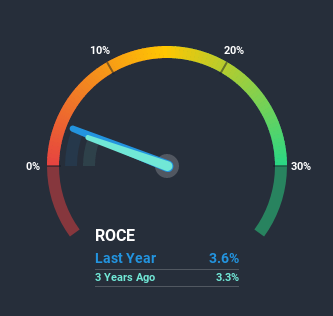
What financial metrics can indicate to us that a company is maturing or even in decline? A business that's potentially in decline often shows two trends, a return on capital employed (ROCE) that's declining, and a base of capital employed that's also declining. Ultimately this means that the company is earning less per dollar invested and on top of that, it's shrinking its base of capital employed. So after we looked into Kishin (KRX:092440), the trends above didn't look too great.
Return On Capital Employed (ROCE): What is it?
For those who don't know, ROCE is a measure of a company's yearly pre-tax profit (its return), relative to the capital employed in the business. Analysts use this formula to calculate it for Kishin:
Return on Capital Employed = Earnings Before Interest and Tax (EBIT) ÷ (Total Assets - Current Liabilities)
0.036 = ₩8.6b ÷ (₩250b - ₩12b) (Based on the trailing twelve months to September 2020).
So, Kishin has an ROCE of 3.6%. In absolute terms, that's a low return and it also under-performs the Machinery industry average of 5.4%.
Check out our latest analysis for Kishin

Historical performance is a great place to start when researching a stock so above you can see the gauge for Kishin's ROCE against it's prior returns. If you want to delve into the historical earnings, revenue and cash flow of Kishin, check out these free graphs here.
What The Trend Of ROCE Can Tell Us
We are a bit worried about the trend of returns on capital at Kishin. Unfortunately the returns on capital have diminished from the 7.7% that they were earning five years ago. And on the capital employed front, the business is utilizing roughly the same amount of capital as it was back then. This combination can be indicative of a mature business that still has areas to deploy capital, but the returns received aren't as high due potentially to new competition or smaller margins. If these trends continue, we wouldn't expect Kishin to turn into a multi-bagger.
What We Can Learn From Kishin's ROCE
In summary, it's unfortunate that Kishin is generating lower returns from the same amount of capital. Long term shareholders who've owned the stock over the last five years have experienced a 27% depreciation in their investment, so it appears the market might not like these trends either. That being the case, unless the underlying trends revert to a more positive trajectory, we'd consider looking elsewhere.
On a separate note, we've found 2 warning signs for Kishin you'll probably want to know about.
While Kishin isn't earning the highest return, check out this free list of companies that are earning high returns on equity with solid balance sheets.
If you’re looking to trade Kishin, open an account with the lowest-cost* platform trusted by professionals, Interactive Brokers. Their clients from over 200 countries and territories trade stocks, options, futures, forex, bonds and funds worldwide from a single integrated account. Promoted
Valuation is complex, but we're here to simplify it.
Discover if Kishin might be undervalued or overvalued with our detailed analysis, featuring fair value estimates, potential risks, dividends, insider trades, and its financial condition.
Access Free AnalysisThis article by Simply Wall St is general in nature. It does not constitute a recommendation to buy or sell any stock, and does not take account of your objectives, or your financial situation. We aim to bring you long-term focused analysis driven by fundamental data. Note that our analysis may not factor in the latest price-sensitive company announcements or qualitative material. Simply Wall St has no position in any stocks mentioned.
*Interactive Brokers Rated Lowest Cost Broker by StockBrokers.com Annual Online Review 2020
Have feedback on this article? Concerned about the content? Get in touch with us directly. Alternatively, email editorial-team (at) simplywallst.com.
About KOSE:A092440
Kishin
Provides mold bases, parts, die sets, and material in South Korea and internationally.
Flawless balance sheet slight.
Market Insights
Community Narratives



